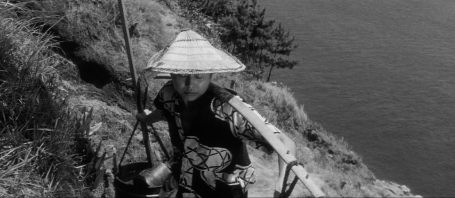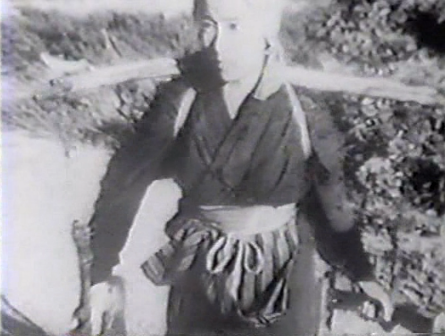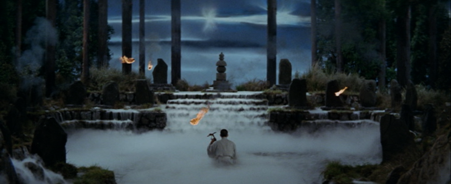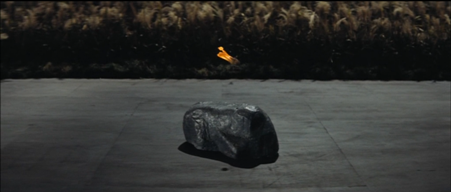Physical Address
304 North Cardinal St.
Dorchester Center, MA 02124

Photo above: Zhang Ziyi and Odagiri Joe in the 2005 Japanese musical Princess Raccoon (Operetta tanuki goten), the final film directed by Suzuki Seijun (1923-2017).
Note: As I’ve already done several times in this blog, I am interrupting my series of reviews of the films of Uchida Tomu to post my general observations on Uchida, his current reputation and his art.
Plot summary: a handsome, distraught young Japanese man dances in a field of yellow flowers. He falls unconscious. A beautiful young female, actually an animal disguised as a human, finds him. This particular type of animal is legendary in native folklore for its shape-shifting abilities (hence its human form) and for its mischievous and unpredictable personality. The beast/woman brings the young man to a protected location, where – despite warnings from others that the worlds of beasts and men don’t mix – she falls in love with him, and he with her. After a number of adventures, they are united happily – but in the end, it’s unclear if either is, in fact, still alive.
To readers of this site, the plot recounted above should seem a familiar one. However, the particular film that the summary describes is not Uchida’s quasi-surreal 1962 historical fantasy The Mad Fox (Koiya koi nasuna koi, 1962), but a much more recent work: Suzuki Seijun’s 2005 musical fantasia – the final film the director made before his death – known in English as Princess Raccoon (Operetta tanuki goten: literally, “Tanuki Palace Operetta”). In this later film, the beast that has transformed itself into a seductive human female (played by the lovely Chinese actress Zhang Ziyi) isn’t a fox, but a raccoon dog, or tanuki (not a raccoon per se, contrary to the misleading English-language title).1 However, there are numerous points of similarity between the two movies, including the opening credit sequence’s evocation of traditional Japanese emakimono (rolling picture scrolls). So if Princess Raccoon is not precisely a remake of The Mad Fox, it certainly could be considered the next best thing to one.
Long before Suzuki made Princess Raccoon, in the late 1950s and early 1960s period during which The Mad Fox was released – the same era in which Suzuki at Nikkatsu served as a director of B-movie crime films and was beginning to cultivate the offbeat (and often off-the-wall) visual flourishes for which he would later become legendary – Uchida was the most powerful director, or kyosho, at the most cutting-edge Japanese studio, Toei. Suzuki at that time could only have dreamt of one day enjoying the prestige (and the budgets) granted freely to Uchida at Toei, not to mention the latter’s high public profile. (In the original trailer, The Mad Fox is advertised as having been made by “the great Tomu Uchida,” making the director’s celebrity a major part of the marketing campaign.2) Yet today, it is Suzuki who is the celebrated cult filmmaker in the West, his work praised and even imitated by famous American filmmakers like Jim Jarmusch and Quentin Tarantino,3 while Uchida – a far more mainstream figure in the Japanese industry during his lifetime – remains utterly obscure in the West. This paradoxical situation strikes me as more than a bit crazy.
There has been, unusually, public acknowledgment of the influence of Uchida’s 1962 film upon Suzuki’s swan song. In his commentary for Arrow Academy’s The Mad Fox Blu-Ray, Jasper Sharp explicitly links Princess Raccoon to The Mad Fox.4 Michael Barrett, in an article published in the online magazine of cultural criticism PopMatters, refers to the “clear connection [of Uchida’s film] to Suzuki’s wild Princess Raccoon,” and also points out a strong link between Uchida’s work and the famous fox wedding scene in the initial episode of Kurosawa Akira’s Dreams (Yume, 1990). And in Mark Asch’s brief survey of Uchida’s oeuvre, he refers to Uchida’s film as “a possible forebear of Seijun Suzuki’s non-sequiterrific [sic] Princess Raccoon.”

However, as we’ve argued in previous posts, the Suzuki film is far from the only Japanese film influenced by an Uchida work. We’ve already asserted, in our reviews on this site, that works as diverse as Kurosawa Akira’s classic detective movie Stray Dog (Nora inu, 1949), Shindo Kaneto’s independent film The Naked Island (Hadaka no shima, 1960) and Kobayashi Masaki’s famous Kwaidan (Kaidan, 1964) are all indebted to previous films by Uchida. (Those Uchida films are, respectively, Police Officer (Keisatsukan, 1933), Earth (Tsuchi, 1939) and The Mad Fox; see the Commentary and Analysis sections in my reviews of these films for further details.) To this impressive list, we might add a film that was clearly very strongly influenced by Uchida’s 1965 classic, A Fugitive from the Past (Kiga kaikyō): Imamura Shohei’s 1979 film Vengeance Is Mine (Fukushū suru wa ware ni ari) – which is fitting, because Fugitive itself was indebted to Imamura’s early 1960s work.5

I’ve recently discovered a scholarly article that makes at least one of these connections explicit: “Real and Slow: The Poetics and Politics of The Naked Island,” written by Lauri Kitsnik and published in 2018.6 In discussing the origins of Shindo’s film, which Kitsnik considers seminal in the subsequent development of Japanese independent film, the author mentions not only the obvious influences of Italian neorealism and Robert Flaherty’s pseudo-documentary Man of Aran, but the far less obvious influence of Uchida’s Earth. Kitsnik includes in the article several images from Uchida’s film – showing the protagonist, Kanji, and his daughter carrying buckets of water to irrigate their crops – in order to demonstrate the similarity of these images to scenes of characters in Shindo’s later film carrying buckets of water for the same purpose.7

However, as far as I know, none of the Japanese filmmakers I’ve cited, nor have any critics or scholars (apart from Kitsnik) reviewing their work, conceded the “phantom thread” of an Uchida connection. For example, Kurosawa, in his autobiography, discusses Stray Dog without once mentioning Uchida or Police Officer,8 and in his personal list of the 100 greatest films of all time, he praises Uchida’s Earth (and also the slightly earlier Unending Advance (Kagirinaki zenshin, 1937)), again without alluding to Uchida’s probable influence on his own Stray Dog and Dreams.

Please note that I’m not accusing these other Japanese film artists of plagiarism or even lack of originality. Such an accusation would be very naïve in any case: great filmmakers routinely stand on the shoulders of other great filmmakers, and the history of cinema is so broad and extensive that a totally original film would be almost unimaginable. What bothers me (perhaps more than it should) is that those artists never seem to have admitted their creative debt to Uchida.9
This unfortunate situation is, I think, one of the reasons Uchida is still virtually unknown in the West, and remains little known – except by cinema critics and scholars – even in his own country. As far as critics are concerned, an artist’s importance, generally speaking, tends to be equated with his/her artistic impact. When we note the obvious fact that nearly every sci-fi movie Hollywood has produced from the 1970s onward reveals the direct or indirect influence of Stanley Kubrick’s legendary 2001: a Space Odyssey (1968), we’re rightly affirming Kubrick’s seminal importance to the history of this genre. Georges Sadoul, in his classic Dictionary of Film Makers, refers to Uchida as “one of the founders of cinematic art in Japan,”10 but that remains one of the few Western texts I’ve come across so far that acknowledges his centrality in Japanese film history.
In other words, so long as film historians and scholars, to the extent that they consider Uchida at all, falsely think of him as an artistic outlier, with no real aesthetic predecessors or successors, I believe they will continue to avoid taking him seriously as an artist.